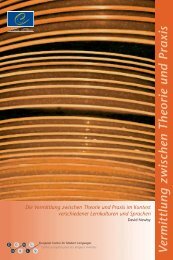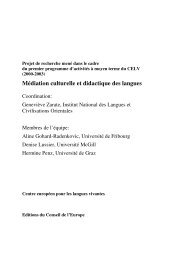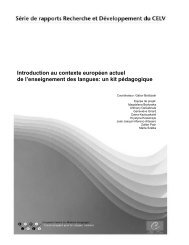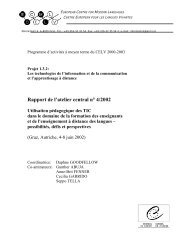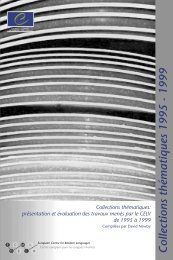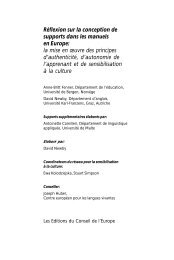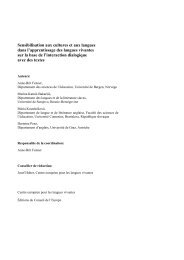cohesion - European Centre for Modern Languages
cohesion - European Centre for Modern Languages
cohesion - European Centre for Modern Languages
Create successful ePaper yourself
Turn your PDF publications into a flip-book with our unique Google optimized e-Paper software.
neighbouring countries have similar musical rhythms and that music is a cultural<br />
element that can contribute to the demolition of barriers.<br />
In order to enable pupils to further elaborate on the soothing nature of music, the<br />
teacher encourages young pupils to talk about fairy tales or myths with relevant<br />
content. For example, The Magic Flute, i.e. the story upon which Mozart’s well-known<br />
opera was based, can be discussed. To explore the content of the story, the teacher can<br />
present pupils with in<strong>for</strong>mation concerning the writer Emanuel Schickaneder’s idea of<br />
integrating the concept of the power of music and its influence on both humans and<br />
animals into the libretto and developing it through the lines of his written work.<br />
Task 2<br />
Initially pupils are presented with a leaflet announcing the Edinburgh pop festival and a<br />
poster advertising the Museum of Popular Instruments in Plaka, Athens. This material<br />
aims to expose pupils to different sources and to encourage them to talk about music<br />
festivals organised in the village or at the resort where they spend their summer holiday<br />
as well as about their favourite kinds of music. Furthermore, pupils can be encouraged<br />
to talk about the musical instruments on the poster. Perhaps they have such instruments<br />
in their homes. They could share their knowledge about particular instruments or even<br />
play an instrument which they know. Finally, they could also explain why they would<br />
like to learn how to play a particular instrument.<br />
Then the pupils can co-operate in teams in order to further reflect upon folk music and<br />
its role as a unifying principle as well as to engage in activities allowing them to use<br />
the English language in order to communicate meanings relevant to the topic under<br />
discussion. To this end, the teacher asks pupils to <strong>for</strong>m groups of 3-4 and to decide on<br />
which of the five continents they are going to focus on. Then they find in<strong>for</strong>mation<br />
concerning musical instruments that the people use to play local music. Moreover, the<br />
teacher asks pupils to search <strong>for</strong> the names of instruments in local languages/dialects on<br />
the Internet and to translate and present them in class. Alternatively, in co-operation<br />
with the music and the art teacher, pupils could construct musical instruments using<br />
material found in most homes. For example, two paper plates, with loose beans inside,<br />
can be glued together along the edges to <strong>for</strong>m a rattle. While clay flowerpots, wire and<br />
a broom handle can be used to make pot chimes.<br />
Moreover, pupils (in pairs of groups) can be asked to produce posters on which they<br />
express their opinions about music by producing comprehensive statements, such as<br />
“music unites people”, “people love to listen to different kinds of music”, etc. Pupils<br />
can also be encouraged to draw illustrations which express their statements on posters.<br />
In this way the theory of multiple intelligences (reading, drawing, visualising, etc) is<br />
taken into account to the benefit of the pupils. Later the posters can be displayed in the<br />
classroom so that the pupils can admire the work of their peers and discuss the<br />
statements with the writers.<br />
106



